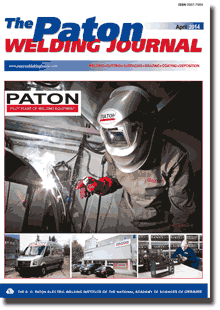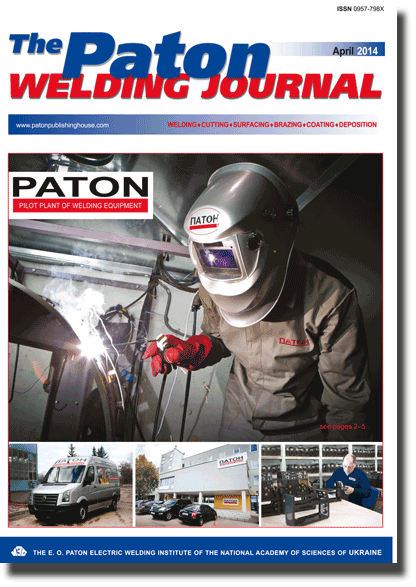| 2014 №04 (02) |
DOI of Article 10.15407/tpwj2014.04.03 |
2014 №04 (04) |

The Paton Welding Journal, 2014, #4, 22-25
EFFECT OF NICKEL AND MANGANESE ON STRUCTURE OF Ag-Cu-Zn-Sn SYSTEM ALLOYS AND STRENGTH OF BRAZED JOINTS
V.F. KHORUNOV, B.V. STEFANIV and S.V. MAKSYMOVA
E.O. Paton Electric Welding Institute, NASU. 11 Bozhenko Str., 03680, Kiev, Ukraine. E-mail: office@paton.kiev.ua
Abstract
It is a well-known fact that alloys of Ag-Cu-Zn-Sn system are a good basis for development of cadmium-free brazing filler metals (BFM) for brazing of different materials. However, as it follows from works of different authors, the BFM of this system are insufficiently active in brazing of hard-alloy materials. This work tries to eliminate these disadvantages. Effect of nickel and manganese alloying in 1-4 wt.% Ni and 2-6wt.%Mn interval is investigated using method of experiment planning. Investigated are the intervals of alloy melting, areas of spreading and wetting angles on different substrates, strength characteristics of the joints in brazing of stainless steels and hard alloys. Structure of pilot alloys is investigated using the methods of optical and electron microscopy and microX-ray spectrum analysis. It is shown that manganese and nickel alloying of Ag-Cu-Zn-Sn system alloys allowed developing BFM, which provide good wetting of hard-alloy materials at the level of BFM of Ag-Cu-Zn-Cd system at filler relationship, approximately, 1.5-2.0 Mn:1.0Ni. Technological properties of BFM deteriorate at 1.0 Mn:1.5-2.0 Ni relationship. Development of environmentally friendly BFM of Ag-Cu-Zn-Sn-Ni-Mn system for brazing of rock destruction and metal-cutting tool allows refusing from application of harmful BFM of Ag-Cu-Zn-Cd system and significantly (per 20-50 %) increasing strength of brazed joints. 5 Ref., 4 Tables, 7 Figures.
Keywords: brazing, cadmium-free brazing filler metals, structure, melting interval, contact wetting angle, induction heating, temperature of phase transformations, nickel, manganese, silver brazing filler metal, joint strength
Received: 04.02.14
Published: 28.04.14
References
1. Roberts, P.M. (1978) Recent developments in cadmium-free silver brazing alloys. Welding J., 10, 23-30.
2. Timmins, P.F. (1994) The development of Ag-based brazing alloys. Ibid., 10, 31-33.
3. Khorunov, V.F., Maksymova, S.V., Stefaniv, B.V. (2010) Effect of tin additions on structure and technological properties of BFM of the Ag-Cu-Zn system. The Paton Welding J., 7, 16-21.
4. Khorunov, V.F., Maksymova, S.V., Stefaniv, B.V. (2012) Effect of palladium on structure and technological properties of Ag-Cu-Zn-Ni-Mn system brazing filler alloys. Ibid., 9, 20-25.
5. Klochko, N.A. (1981) Principles of technology of brazing and heat treatment of hard-alloy tool. Moscow: Metallurgiya.
Suggested Citation
V.F. KHORUNOV, B.V. STEFANIV and S.V. MAKSYMOVA (2014) EFFECT OF NICKEL AND MANGANESE ON STRUCTURE OF Ag-Cu-Zn-Sn SYSTEM ALLOYS AND STRENGTH OF BRAZED JOINTS. The Paton Welding J., 04, 22-25.The cost of subscription/purchase order journals or individual articles
| Journal/Currency | Annual Set | 1 issue printed |
1 issue |
one article |
| TPWJ/USD | 384 $ | 32 $ | 26 $ | 13 $ |
| TPWJ/EUR | 348 € | 29 € | 24 € | 12 € |
| TPWJ/UAH | 7200 UAH | 600 UAH | 600 UAH | 280 UAH |
| AS/UAH | 1800 UAH | 300 UAH | 300 UAH | 150 UAH |
| AS/USD | 192 $ | 32 $ | 26 $ | 13 $ |
| AS/EUR | 180 € | 30 € | 25 € | 12 € |
| SEM/UAH | 1200 UAH | 300 UAH | 300 UAH | 150 UAH |
| SEM/USD | 128 $ | 32 $ | 26 $ | 13 $ |
| SEM/EUR | 120 € | 30 € | 25 € | 12 € |
| TDNK/UAH | 1200 UAH | 300 UAH | 300 UAH | 150 UAH |
| TDNK/USD | 128 $ | 32 $ | 26 $ | 13 $ |
| TDNK/EUR | 120 € | 30 € | 25 € | 15 € |
AS = «Automatic Welding» - 6 issues per year;
TPWJ = «PATON WELDING JOURNAL» - 12 issues per year;
SEM = «Electrometallurgy Today» - 4 issues per year;
TDNK = «Technical Diagnostics and Non-Destructive Testing» - 4 issues per year.


